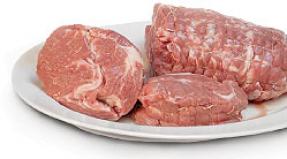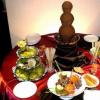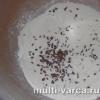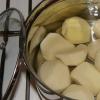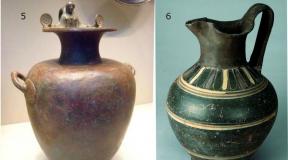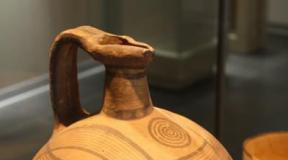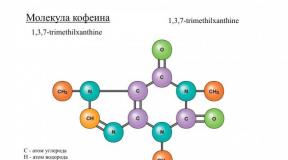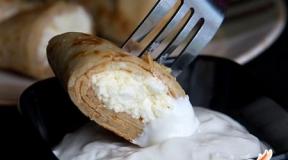Technological cards for the cafe. Technological maps for catering establishments
In order to use the recipe for cooking a dish in the technological chart, it is necessary to perform calculations according to the following formulas:
Given:
x- the weight of the finished dish according to the proportions of the recipe of the technological chart
y- the weight of raw materials for the finished dish according to the proportions of the recipe of the technological chart
z-weight of one serving of the dish (according to your need)
a- Weight of one ingredient of raw materials for the production of a dish
Objective: It is necessary to prepare 100 servings of the dish according to the technological card.
1. Find out the total weight of raw materials for the preparation of a given number of servings
2. Find out the weight of each individual ingredient to prepare a given number of servings
For example, the specified number of servings is 100
1.100 / (X / Z) = number of repetitions of this recipe to make 100 servings
2.a * (x / z) * 100 / (x / z) = the weight of one ingredient to deliver 100 servings.
Examples of
Eggplant in a nut crust
| Set of raw materials |
Output of finished products |
||
|
Gross |
Net |
||
| Eggplant |
675/500 |
||
| Mayonnaise | |||
| Walnuts | |||
| Garlic | |||
| Vegetable oil | |||
| Greenery | |||
Cooking technology.
Chop the nuts, chop the garlic. Cut the eggplants into slices. Combine mayonnaise with nuts and garlic, mix thoroughly. Eggplants are dipped in the resulting mixture and fried in vegetable oil.
Pomegranate salad
| Set of raw materials |
Food consumption per 100 servings |
Output of finished products |
|
|
Gross |
Net |
||
| Beef (brisket, crumbled, ... ..) | |||
| Boiled meat mass | |||
| Onion | |||
| Vegetable oil | |||
| Mass of sautéed onions | |||
| Mayonnaise | |||
| Apples | |||
| Boiled beets | |||
| Walnuts | |||
| Garnet | |||
Output of one portion of semi-finished products ___________________
The output of one portion of the finished product in grams _____ 1000___
Cooking technology.
Boiled meat is cut into strips. Cut onions in half rings, sauté until cooked in vegetable oil. Apples with the seed nest removed, peeled, cut into strips. Boiled beets are peeled and grated. The pomegranates are peeled. Walnuts are fried and chopped. The prepared ingredients are placed in the following sequence: meat, onions, mayonnaise, apples, nuts, beets, mayonnaise.
Elite salad
| Set of raw materials |
Food consumption per 100 servings |
Output of finished products |
|
|
Gross |
Net |
||
| Green beans | |||
| Pine nuts | |||
| Shrimps | |||
| Sweet pepper | |||
| Vegetable oil | |||
| Greenery | |||
| Or crab sticks | |||
Output of one portion of semi-finished products ___________________
The output of one portion of the finished product in grams _____ 1000_
Cooking technology.
The beans are boiled and cut. Boil shrimps, peel sweet peppers, cut into strips. The prepared components are combined, filled with vegetable oil. Decorated with herbs and pine nuts.
Any catering establishment is obliged to start technological cards - this is required by law. Today we will tell you: what are technical maps, what they are and how to automate work with technological maps.
What is a technological map
In general, a technical map is a document containing information about the ingredients of a dish and how to prepare it... It contains the following information:
- the number and name of the products that make up the dish;
- recipe;
- rules of registration and submission.
The procedure for drawing up, maintaining and storing technological maps is regulated by GOST 31987-2012 "Public catering services". This document is mandatory for use at all catering establishments, regardless of the form of ownership. Failure to comply with this requirement threatens with penalties in accordance with the Code of Administrative Offenses of the Russian Federation.
Sample routing
What are the technological cards
Simple technological map - TC
Starts up on dishes prepared according to standard recipes. Such recipes are indicated in culinary guides and approved by the relevant GOSTs. In this case, simplified requirements are applied to the document: only the composition and recipe are indicated. At the request of the organization, you can specify the nutritional value. An important point: the TC must indicate the source of the recipe... This can be a link to a reference book or GOST, from which it was taken.
Simple shopping malls are used to prevent catering companies from reinventing the wheel every time. It makes no sense to develop your own recipe for boiled potatoes in each dining room - this process is formulaic. The rules for registering a shopping mall according to a simplified scheme are specified in GOST 31987-2012 "Catering services".

Technical and technological map - TTK
But here everything is more complicated. Such a document is developed for each new dish, which is not in any reference book. There is much more information here. The TTK must indicate:
- the name of the organization that developed the technical and technological map;
- application area. In this paragraph, a list of catering establishments is written that can use the recipe at home;
- raw material requirements. Here is a list of accompanying documents, security confirmation, and so on;
- name and quantity of ingredients;
- the total mass of the dish at the exit. During cooking or heat treatment, dishes may lose some of their weight - this must be taken into account;
- complete description of the technological process. Everything is taken into account: from the methods of cutting products to the time of heat treatment. For each typical process, you need to indicate a reference to GOST or the regulatory document according to which it is carried out. For imported products, their recommendations are used;
- requirements for the design and rules for serving dishes, as well as storage conditions;
- quality and safety parameters. This paragraph describes the appearance, nutritional value of the dish, its taste and smell.
The TTK is developed by the responsible person and approved by the head of the catering establishment.

Technical and technological map of Greek salad
ТК and ТТК must be printed, have live signatures with seals and kept in an accessible place. They must be presented at the request of the inspection authorities.
Below you can download samples of technical data sheets for some dishes and drinks:
Technological maps are drawn up not only for catering products, but also in any other area where products are made from any raw material.
Technological maps and inventory systems
Try all the features of the EKAM platform for free
Read also
Privacy agreement
and processing of personal data
1. General Provisions
1.1. This agreement on confidentiality and processing of personal data (hereinafter referred to as the Agreement) is freely accepted and of its own free will, applies to all information that LLC "Inseils Rus" and / or its affiliates, including all persons belonging to the same group with LLC "Insails Rus" (including LLC "EKAM service") may receive information about the User while using any of the sites, services, services, computer programs, products or services of LLC "Insails Rus" (hereinafter referred to as the Services) and the course of execution of any agreements and contracts with the User by Insales Rus LLC. The User's consent to the Agreement, expressed by him within the framework of relations with one of the listed persons, applies to all other listed persons.
1.2 Use of the Services means the User agrees with this Agreement and the terms and conditions specified therein; in case of disagreement with these conditions, the User must refrain from using the Services.
"Insails"- Limited Liability Company "Inseils Rus", OGRN 1117746506514, INN 7714843760, KPP 771401001, registered at the address: 125319, Moscow, Akademika Ilyushin st., 4, building 1, office 11 (hereinafter - "Insales" ), on the one hand, and
"User" -
or an individual who has legal capacity and is recognized as a participant in civil relations in accordance with the legislation of the Russian Federation;
or a legal entity registered in accordance with the legislation of the state of which such a person is a resident;
or an individual entrepreneur registered in accordance with the legislation of the state of which such a person is a resident;
which has accepted the terms of this Agreement.
1.4 For the purposes of this Agreement, the Parties have determined that confidential information is information of any nature (production, technical, economic, organizational and others), including the results of intellectual activity, as well as information about the methods of carrying out professional activities (including, but not limited to: information about products, works and services; information about technologies and research projects; information about technical systems and equipment, including software elements; business forecasts and information about prospective purchases; requirements and specifications of specific partners and potential partners; information, related to intellectual property, as well as plans and technologies related to all of the above) communicated by one party to the other in writing and / or electronic form, explicitly designated by the Party as its confidential information.
1.5. The purpose of this Agreement is to protect confidential information that the Parties will exchange during negotiations, concluding contracts and fulfilling obligations, as well as any other interaction (including, but not limited to, consulting, requesting and providing information, and performing other instructions).
2. Obligations of the Parties
2.1. The Parties agree to keep secret all confidential information received by one Party from the other Party during the interaction of the Parties, not to disclose, disclose, disclose or otherwise provide such information to any third party without the prior written permission of the other Party, with the exception of cases specified in the current legislation, when the provision of such information is the responsibility of the Parties.
2.2. Each of the Parties will take all necessary measures to protect confidential information at least using the same measures that the Party applies to protect its own confidential information. Access to confidential information is provided only to those employees of each of the Parties who reasonably need it to perform their official duties for the implementation of this Agreement.
2.3. The obligation to keep confidential information in secret is valid within the term of this Agreement, the license agreement for computer programs dated 01.12.2016, the agreement of accession to the license agreement for computer programs, agency and other agreements and for five years after termination their actions, unless the Parties separately agree otherwise.
(a) if the information provided has become publicly available without violating the obligations of one of the Parties;
(b) if the information provided has become known to the Party as a result of its own research, systematic observations or other activities carried out without the use of confidential information received from the other Party;
(c) if the information provided is lawfully obtained from a third party without an obligation to keep it secret until it is provided by one of the Parties;
(d) if the information is provided at the written request of a state authority, other state authority, or local self-government body in order to perform their functions and its disclosure to these authorities is mandatory for the Party. In this case, the Party must immediately notify the other Party of the received request;
(e) if the information is provided to a third party with the consent of the Party, the information about which is being transferred.
2.5. Insales does not verify the accuracy of the information provided by the User, and is unable to assess his legal capacity.
2.6. The information that the User provides to Inseils when registering in the Services is not personal data, as they are defined in the Federal Law of the Russian Federation No. 152-ФЗ dated 07/27/2006. "About personal data".
2.7 Insales reserves the right to amend this Agreement. When changes are made in the current edition, the date of the last update is indicated. The new version of the Agreement comes into force from the moment it is posted, unless otherwise provided by the new version of the Agreement.
2.8. By accepting this Agreement, the User realizes and agrees that Inseils can send the User personalized messages and information (including but not limited to) to improve the quality of the Services, to develop new products, to create and send personal offers to the User, to inform the User about changes in Tariff plans and updates, to send the User marketing materials related to the Services, to protect the Services and Users and for other purposes.
The user has the right to refuse to receive the above information by notifying this in writing to the email address of Inseils -.
2.9. By accepting this Agreement, the User understands and agrees that the Inseils Services may use cookies, counters, other technologies to ensure the performance of the Services in general or their individual functions in particular, and the User has no claims against Inseils in this regard.
2.10 The user is aware that the equipment and software used by him to visit sites on the Internet may have the function of prohibiting operations with cookies (for any sites or for certain sites), as well as deleting previously received cookies.
Insails has the right to establish that the provision of a certain Service is possible only provided that the acceptance and receipt of cookies is permitted by the User.
2.11. The user is solely responsible for the security of the means chosen by him to access the account, and also independently ensures their confidentiality. The User is solely responsible for all actions (as well as their consequences) within or using the Services under the User's account, including cases of voluntary transfer by the User of data to access the User's account to third parties on any terms (including under contracts or agreements) ... At the same time, all actions within or using the Services under the User's account are considered to have been performed by the User himself, except for cases when the User has notified Inseils about unauthorized access to the Services using the User's account and / or about any violation (suspicions of violation) of the confidentiality of his account access means.
2.12 The User is obliged to immediately notify Insails about any case of unauthorized (not authorized by the User) access to the Services using the User's account and / or about any violation (suspicion of violation) of the confidentiality of his account access means. For security reasons, the User is obliged to independently carry out a safe shutdown under his account at the end of each session of work with the Services. Insales is not responsible for possible loss or damage to data, as well as other consequences of any nature that may occur due to violation by the User of the provisions of this part of the Agreement.
3.Responsibility of the Parties
3.1. A Party that has violated the obligations stipulated by the Agreement regarding the protection of confidential information transferred under the Agreement is obliged to compensate, at the request of the affected Party, for real damage caused by such a violation of the terms of the Agreement in accordance with the current legislation of the Russian Federation.
3.2. Compensation for damage does not terminate the obligations of the offending Party to properly fulfill its obligations under the Agreement.
4.Other provisions
4.1. All notices, inquiries, requirements and other correspondence under this Agreement, including those that include confidential information, must be made in writing and handed in personally or through a courier, or sent by e-mail to the addresses specified in the license agreement for computer programs of 12/01/2016, the agreement of accession to the license agreement for computer programs and in this Agreement or other addresses that may be further indicated in writing by the Party.
4.2 If one or more provisions (conditions) of this Agreement are or become invalid, then this cannot serve as a reason for the termination of other provisions (conditions).
4.3 The law of the Russian Federation shall apply to this Agreement and the relationship between the User and Insales arising in connection with the application of the Agreement.
4.3. All suggestions or questions regarding this Agreement, the User has the right to send to the Inseils User Support Service or to the postal address: 107078, Moscow, st. Novoryazanskaya, 18, str. 11-12 Business center "Stendhal" LLC "Inseils Rus".
Date of publication: 01.12.2016
Full name in Russian:
Limited Liability Company "Insales Rus"
Abbreviated name in Russian:
LLC "Insales Rus"
Name in English:
InSales Rus Limited Liability Company (InSales Rus LLC)
Legal address:
125319, Moscow, st. Academician Ilyushin, 4, building 1, office 11
Mailing address:
107078, Moscow, st. Novoryazanskaya, 18, p. 11-12, BC "Stendhal"
INN: 7714843760 Checkpoint: 771401001
Bank details:
Now watching: 5 056
How TC and TTK are formalized
The main documents on the basis of which dishes are prepared are technological (TC) and Technical and technological cards (TTC). They are mandatory documents for any catering establishment, and must be developed for the entire list of dishes. When developing HACCP procedures, they are also necessary, since used in the production description.
Let's consider their differences.
A technological map is developed for each dish, based on a collection of recipes for public catering.
TC must contain the following information:
- list (composition) of products (ingredients);
- the mass of the ingredients used;
- the mass of the finished product;
- the mass of one portion;
- a description of the technological process of manufacturing products;
- a description of the design of the dish (appearance);
- a description of the serving of the dish (product);
- storage conditions;
- storage periods.
The recipe indicates the consumption rates of gross and net products for one or more servings, or for one or more kg, the output (net weight) of semi-finished products and the output of public catering products (culinary semi-finished products, dishes, culinary, bakery and flour confectionery products).
As a source of recipes, it is allowed to use Collections of recipes for catering establishments or other sources operating in the territory of the state that adopted the standard.
Technical and technological map (TTK)- is being developed only for new non-traditional products manufactured for the first time at a public catering enterprise. Which is absent in the collection of recipes.
The TTK establishes requirements for the quality of raw materials and food products, product recipes, requirements for the manufacturing process, design, sale and storage, quality and safety indicators, as well as the nutritional value of public catering products.
The technical and technological map contains the following sections:
- application area;
- requirements for raw materials;
- recipe (including the rate of consumption of raw materials and food products gross and net, weight (output) of a semi-finished product and / or output of a finished product (dish);
- technological process;
- requirements for the design, supply, sale and storage of public catering products;
- indicators of quality and safety of public catering products;
- informational data on the nutritional value of public products
nutrition.
Sources:
- GOST 31985-2013. Interstate standard. Catering services. Terms and Definitions
- GOST 31987-2012 Catering services. Technological documents for public catering products. General requirements for design, construction and content
Good luck and prosperity to your company.
Nowadays, as a rule, the vast majority of businesses develop signature dishes. (In principle, a signature dish is any dish that is not made according to the Collection of Technological Standards, or the Collection of Recipes). For such products (dishes), enterprises must develop Technical and Technological Maps (TTC). The form and content of the TTK from January 1, 2015 is regulated by GOST 31987-2012.
At catering establishments, the development of the TTK, as a rule, causes difficulty, and in many cases, chefs and accountants - calculators are involved in the development of the TTK, as a result, the resulting documentation rarely meets the requirements. At many enterprises, the development of the TTK is reduced to the preparation of a recipe and filling in the preparation technology (Usual Technological Map). Such documentation does not comply with the Technical Regulations of the Customs Union (TR CU 021-2011). As a result, the company pays large fines for non-compliance of the documentation with the requirements.
In 2007, amendments were made to the "Rules for the provision of public catering services" (Decree of the Government of the Russian Federation dated May 10, 2007 No. 276), which obliges public catering enterprises to indicate the nutritional value of products. But, even with the experience of drawing up the TTK and all the necessary documentation, the development time for one TTK without using the automation program for technological calculations can take up to 3-4 hours (with the calculation of calorie content, physical chemistry, microbiology and other indicators)!
We have been developing TTK for public catering enterprises for more than fifteen years, during which time we have developed a large methodological base.
Since January 2015, we have been developing documents in accordance with GOST 31987-2012 and with the requirements of the Technical Regulations of the Customs Union TR CU 021-2011. The new form of the TTK has been developed in accordance with the Interstate Standard, and approved for use by countries such as Kazakhstan, Kyrgyzstan, Russia, Tajikistan and Uzbekistan.
In addition to updating the form of the TTK itself, we calculate the energy value in kJ, the calculation of nutrients as a percentage of the average daily requirement.
Now the set of documents also includes an Information sheet containing detailed information about dishes and products, including information about Allergens, dietary supplements, GMOs, as well as the composition of the dish.
When calculating losses during cold and heat treatment of a product, we are guided not only by tabular data on the Collection of recipes. Our database also contains actual product losses, which often differ from STN. You can check the compliance of the recipes of the enterprise for the correctness of the bookmarking norms, and prevent financial losses!
The technical and technological map (TTC) is signed by the head of the enterprise and the developer. As a rule, there is no need to assure TTK in Rostpotrebnadzor. But in some cases (for example, if you sell products outside the enterprise, through other retail outlets), the TTK is not enough, and it is necessary to develop Specifications and go through the certification procedure.
When developing a Technical Technological Map, we provide a full set of documents necessary for the operation of a catering enterprise:
- Technical and technological map
- Costing card (costing dishes) at average Russian prices
- Control study act
- Substantiation of calculations of calorie content, mass fractions of salt, sugar, fat, dry substances, microbiology
- Calorie leaf
- Information sheet
- Technological map (for dishes made according to the official Compilation of recipes)
- Mini - recipes (bookmarks for chefs)
The development of documents is carried out by our technologists in the program of technological calculations "Chief Expert" created by us.
Examples of documents developed in the "Chief Expert" program
How to order the development of a Technical Technological Map and a set of documents for a catering company?
The order of order and payment is as follows:
- You fill out the Form for the development of the TTK. After receiving the questionnaire, we prepare an offer for you on the cost and development time. If you do not want to fill out the form, write or call us;
- After a positive answer, we will send you an electronic contract and an invoice for payment. (If the conclusion of the Agreement in paper form, with a signature and a seal is not important for you, we are guided by the Offer Agreement);
- You pay an Advance payment in the amount of at least 1/3 of the cost of work;
- Upon completion of development, we will send you an Information sheet, which contains detailed information about the dishes, and confirms that the documents have been developed in full;
- You pay the remaining amount, we send a full set of technological documentation (in MS Word (RTF), Excel or PDF format, of your choice). After that, by registered mail, you will be sent documents confirming the fact of payment (original invoice, Service Agreement, Certificate of Completion).
The term for the Development of the TTK depends on the number and complexity of the dishes. On average, 50 TTKs are developed within 5-7 working days.
The cost of a standard calculation of a set of documents for a dish is 290 rubles. Standard calculation means the calculation of documentation according to the customer's recipe, without a set of cooking technologies (or with copying text from an electronic medium), with the calculation of a calculation card at average prices.
In the presented menu there are specialties, one of which is "Roast with mushrooms in pots" Director of the cafe "" 2014 TECHNICAL AND TECHNOLOGICAL CARD № 1. Figure 1 - "Roast with mushrooms in pots" Scope This technical and technological map applies on the dish "Roast with mushrooms in pots" produced by the restaurant "Canteen №1" and its branch, while all the necessary requirements for its preparation are observed. List of raw materials For the preparation of the second hot dish "Roast with mushrooms in pots", the following raw materials are used: Beef GOST R 54315-2011 Potatoes GOST R 51808-2001 Onions GOST R 51783-2001 Butter GOST R 37-91 Raw materials used for cooking the second hot dish "Roast with mushrooms in pots" must comply with the requirements of regulatory documents, have certificates and quality certificates.
How to draw up a technological map for a dish
NEW College: Nutrition A computer program for organizing meals and accounting for products in institutions of primary and secondary vocational education. make an order version for printing 1100 recipes of dishes (technological maps), chemical composition and nutritional value of dishes, culinary products, semi-finished products. In this section you will find a new reference book (recipe book), which contains technological charts (recipes) for cooking more than 1100 dishes.
The norms for the laying of products, semi-finished products (embedded dishes), gross and net, per 100 grams of the mass of the finished dish have been published. The nutritional value and chemical composition of each dish is given, including the content of proteins (proteins, polypeptides), fats (triglycerides, lipids), carbohydrates (saccharides), calorie content (kcal), the content of vitamins: B1 (thiamine), B2 (riboflavin), C (ascorbic acid), minerals: Ca (calcium), Fe (iron).
How to draw up a technological map of a dish
In order to ensure a sufficient level of competence of the employees involved in the departments, an example of drawing up a technological map of an enterprise is provided. Thus, their first function is teaching.
The second task is to regulate a certain order of actions where it is possible to use different options for work. Often the most rational methods are chosen by development specialists.
The third task is to ensure the fastest possible involvement in the new process and professional development of already working professionals. And a planned, well-written instruction will help them with this.
It follows that the flow chart should be drawn up in such a way that the least qualified employee of the enterprise can intuitively understand it, and competent specialists can find the required tips for themselves in their work.
Technological map of the dish. how to calculate?
Also meticulously and painstakingly include everything that occurs in the text here. Do not forget the names of the companies you do business with that are mentioned in the document.
Perhaps you use the services of a hired vehicle, then be sure to indicate who falls under the definition of a carrier. If your routes have separate names, be sure to decode them.
Attention
Remember abbreviations. They should also be included in this section. 5. General provisions and the main text of the technological map.
This is the longest section of the document. It includes a description of the organization of the process, technological features, routes. This can also include requirements for the quality of work and methods for assessing this quality.
Describe all the materials and resources you need to organize the process.
How to draw up technological cards?
Onions are chopped and sautéed, chopped boiled mushrooms are added and frying is continued for 3-5 minutes. The flour sautéed in fat is diluted with hot mushroom broth to a homogeneous consistency, boiled for 20-25 minutes, salt is added and filtered, then the sautéed onion with mushrooms is placed and boiled for 10-15 minutes.
At the end of cooking, add sour cream and bring to a boil. Registration, filing, sale and storage. The second hot course "Pot Roast with Mushrooms" is served in a pot, sprinkled with chopped herbs.
Serving temperature of the dish should be 65 C. The term of realization of "Roast with mushrooms in pots" - immediately after preparation. Quality and safety indicators. Organoleptic characteristics of the dish: Appearance - the potato has the correct shape, the filling occupies the entire space of the inner part of the potato, the crust is moderately brown, homogeneous.
The consistency is soft.
Technical and technological map of the dish
The collection of recipes (technological standards) must develop a document "Technical and technological map". However, not everyone understands how the TTK differs from the Technological map, and how it should look. In this article we will try to give a detailed answer to this question. So, the requirements for the design of the TTK and the information contained therein are detailed in GOST 31987-2012.
We will not describe in detail the content of GOST, we will limit ourselves only to a description of the main features: Unlike the Technological Map, in the Technical and Technological, along with the calculation of calorie content, it is necessary to indicate the following indicators:
- Organoleptic indicators
- Physicochemical indicators (mass fraction)
- Microbiological indicators for the corresponding food group
Below we give a methodology for developing the TTK, and describe in detail the calculation of all the necessary indicators.
1100 recipes
In the event that the manufactured products are subject to long-term storage, reflect the conditions and shelf life in the technological map. 6 When making a map, adhere to the requirements of the National Standard of the Russian Federation GOST R 50763-2007 “Catering services. Public catering products sold to the population. General technical conditions ". It regulates the content and design of the technological map for public catering products. 7 Sign the technological card by the chef or production manager, approve it by the head of the catering establishment. Pay attention The site contains a collection of the best recipes and recipes for dishes: recipes for baking bread, recipes for fish dishes, a catalog of recipes for salads, etc. Useful advice Organization of catering / Ready menu (download).
Sample recipe for a dish
You can add 50 to 100 grams of green peas to the vinaigrette by reducing pickles or sauerkraut accordingly. TECHNOLOGICAL CARD № 2 Figure 3 - Siberian borsch Table 6 - Technological map Name of products For the estimated number of portions 1 portion 4 portions 100 portions Gross, g Net, g Gross, g Net, g Gross, g Net, g 1 2 3 4 5 6 7 Beets 48 39 192 156 4800 3900 Fresh cabbage 24 19 96 76 2400 1900 Potatoes 13 9.5 52 38 1300 950 Beans 9 9 36 36 900 900 Carrots 12 9 48 36 1200 900 Onions 11.5 9 46 36 1150 900 Tomato puree 7 7 28 28 700 700 Cooking oil 4 4 16 16 400 400 Garlic 1 1 4 4 100 100 Granulated sugar 2 2 8 8 200 200 Vinegar 3% 1.5 1.5 6 6 150 150 Water 193 193 772 772 19300 19300 Yield 250 Cooking technology Chopped cabbage is placed in boiling broth or water and boiled for 10-15 minutes.
Sample technological map of Ukraine dish
The protein content in 100 grams of the ‘Fat mesh (Spice)’ ingredient = 1.4 grams. The net weight of the ingredient ‘Fat net (Spice)’ according to the recipe = 42 grams, therefore, the amount of protein in the ingredient = 42/100 * 1.4 = 0.59 grams (item 7 in item 1). This ingredient IS EXPLODED to heat treatment, therefore, the loss of protein during heat treatment is determined according to the reference data = 10% (article 10 in volume 1). Thus, the total amount of protein in the ingredient = 0.59 * (100-10) / 100 = 0.53 grams. (Article 14 in Volume 1) 1.2.
Info
The ingredient ‘Fat net (Pryatina)’ DOES NOT HAVE TECHNOLOGICAL LOSSES after heat treatment (article 13 in volume 1), therefore the total amount of protein in the ingredient = 0.53 * (100-0) / 100 = 0.53 grams. 1.3. The ‘Fat Net (Spice)’ ingredient is CONSIDERED in the dish outlet (article 17 in volume 1), therefore the protein content is CONSIDERED in the total protein content of the dish.
1.4.
An example of drawing up a technological map of a dish
Examples of a technological map are present in any production, be it an aircraft plant or a public catering facility. This standardized document is mandatory in the enterprise, however, the form and appearance differ from industry to industry. What is it? Examples of routing include the required information for workers performing a specific operation. It can take the form of a procedure or instruction, be presented in the form of text, tables, graphs, recipes, action plans, and so on. What it should be In whatever form the examples of the technological map were executed, it should answer the following questions: 1. What to perform (what operations or procedures). 2. How to perform (specific steps are described in a specific order and sequence). 3. How often they should be done (regulated regularity, frequency). 4.
Recipe The recipe for the dish "Pot Roast with Mushrooms". Table 3 - Technological map Name of raw materials Gross weight (g) Net weight (g) Beef 162 119 Potatoes 253 190 Onions 30 25 Tomato puree 12 12 Salt 12 12 Pepper 10 10 Yield 325 Technological process Preparation of raw materials for the production of the second hot dish "Roast with mushrooms in pots ", is produced in accordance with the Collection of recipes for dishes and culinary products for public catering enterprises (2010).
Cooking technology Meat is cut into cubes, sprinkled with salt and pepper, fried. The potatoes are cut into cubes and fried. Onions are cut into half rings and sautéed. Put meat in a pot, potatoes, onions on it, pour sour cream-mushroom sauce and stew. For the sauce, prepared dried mushrooms are soaked and boiled. The broth is filtered, the mushrooms are washed, cut into strips.
Example of filling out a recipe for a dish
I have worked for a long time in the field where they are developed and applied, and therefore I can tell you about them. And I even have a second education in the specialty of a restaurant technologist.
They work with them in the kitchen of a restaurant or cafe, and in any dining room. A technological card is developed for any first, second course, or an appetizer, salad, and even for drinks and any cocktails such a card is developed.
Here is an example of what this card looks like for a first course. The card must be approved by the head, it is calculated according to the recipe book, meaning the tab of the product. The name of the dish is written, from which number of the collection it was taken, and a bookmark is made for 100 servings and for one. And the portion output is shown. Cards exist so that the bookmark of products is respected, and also so that you can make a record of the consumption of products in the kitchen.


